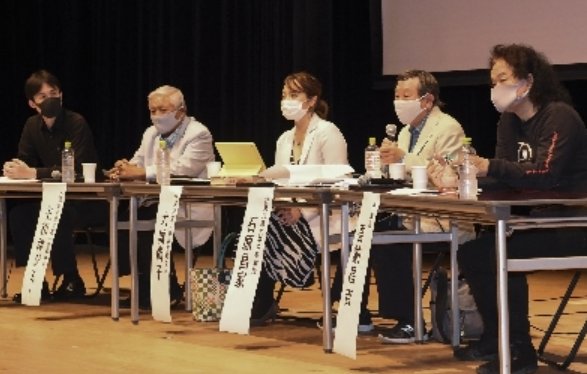“A day of restoring pride as human beings”–naming and present-day significance of Koza riot debated at 50th anniversary symposium

Speakers offering their views at the symposium reflecting on the 50th anniversary of the Koza riot on the afternoon of December 13 at the Ryukyu Shimpo Hall in Izumizaki, Naha (photograph by Moriaki Kise)
December 13, 2020 Ryukyu Shimpo
As the 50th anniversary of the 1970 Koza Riot on December 20 approaches, the Okinawa Asia International Peace Art Project 2020 Steering Committee and the Ryukyu Shimpo held a “Symposium for Asking Questions on the 50th Anniversary of the Koza Riot” on December 13 at the Ryukyu Shimpo Hall in Izumizaki, Naha. Speakers Masaie Ishihara (Okinawa International University professor emeritus), Shoko Oshiro (Okinawa International University part-time instructor), Shokichi Kina (musician), and Jimmy Schwartz(former high commissioner specialist 1st class) discussed the significance of the Koza Riot and other matters. Around 150 people attended the symposium.
Professor Ishihara first redefined the event based on newspaper articles from the day it occurred and several days following, describing it as not a riot by the masses but “more appropriately as a ‘Koza anti-U.S.-military citizen’s uprising’”, and then stated, “it was a day that people restored their pride as human beings, and amidst the fires was a liberated people’s zone.”
Professor Oshiro discussed the words used by news reporters and scholars and pointed out that “‘riot’ and ‘unrest’ are words used by the rulers.” She then explained, “we should think about how to translate in present-day terms.”
Schwartz discussed his own upbringing and described his complicated state of mind, saying, “as both an Uchinanchu and an American, I felt torn.” He explained that he went to observe the scene by car with James B. Lampert, then the high commissioner of the United States Civil Administration of the Ryukyu Islands (USCAR). “[The high commissioner] didn’t say anything, but being in the position of someone responsible, I think he felt pained,” said Schwartz, recalling the experience.
Kina said, “what was the energy present at that time? It was the closest energy to independence we’ve felt. We’ve reached the time to think about the reversion movement and our identity.”
A viewing of video footage captured at the time of the riot and a performance by Kina were held prior to the symposium.
(English translation by T&CT and Sandi Aritza)
Previous Article:Yomitan requests Defense Bureau access to place of worship located on U.S. military base
Next Article:Karate – Kiyuna wins record-setting ninth straight All-Japan Emperor’s Cup, highlighted by his performance of the Anan kata
[Similar Articles]
- “Okinawa’s struggle on the edge of non-violence” discussed at Naha symposium 50 years after Koza riot, links to the present explored
- Photographers discuss significance of Koza riot
- Special exhibit reflects on 50 years since the Koza Riots, open through January 2021
- Walking tour around scene of Koza riot to learn about nonviolence
- Walking tour of Koza resumes after three-year hiatus, including the taco stand featured in the movie “Miracle City Koza”
 Webcam(Kokusai Street)
Webcam(Kokusai Street)


